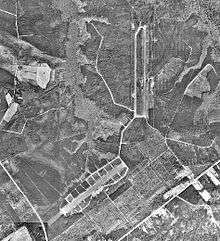Marine Corps Outlying Field Camp Davis
| MCOLF Camp Davis Greater Sandy Run Training Area | |||||||||||||||
|---|---|---|---|---|---|---|---|---|---|---|---|---|---|---|---|
 USGS aerial image – 8 March 1993 | |||||||||||||||
| IATA: none – ICAO: none – FAA LID: 14NC | |||||||||||||||
| Summary | |||||||||||||||
| Airport type | Military | ||||||||||||||
| Owner | U.S. Navy | ||||||||||||||
| Location | Onslow County, near Holly Ridge, North Carolina | ||||||||||||||
| Built | 1940 by U.S. Army | ||||||||||||||
| Elevation AMSL | 60 ft / 18 m | ||||||||||||||
| Coordinates | 34°31′00″N 077°33′00″W / 34.51667°N 77.55000°W | ||||||||||||||
| Runways | |||||||||||||||
| |||||||||||||||
Marine Corps Outlying Field (MCOLF) Camp Davis[2] (FAA LID: 14NC) is a military use airport southeast of the central business district of Holly Ridge,[1] in Onslow County, North Carolina, United States.[3] It is used a training facility by the United States Marines of Camp Lejeune and MCAS New River.
History
In late December 1940,[4] Camp Davis was built by the United States Army as an antiaircraft artillery training facility. Manned by about 20,000 officers and men, Camp Davis was attached to the First Army, Fourth Corps Area. It was an expansive facility consisting of more than 3,000 buildings on 45,538 acres (184 km2) with access provided by newly built railroad spurs leading into the camp.
Between 1942–43, two 5,000 feet (1,500 m) paved runways were built for Camp Davis Army Air Field (AAF). Part of the runway for the airfield was built through one of the old Civil War fort's walls.
Camp Davis AAF's Runway 5/23 was wider, and was intended for use by transports, while Runway 19/01 was narrower and intended for use by single-engine aircraft. Most of the aircraft operated from Camp Davis runways were single-engine aircraft used to tow targets for the anti-aircraft artillery units.
During World War II the Camp Davis housed approximately 550 German prisoners.[5]
In 1944 the anti-aircraft training facility was transferred to Fort Bliss, and on 17 February 1946, Camp Davis was closed.[6]
Circa 1 June 1946,[6] a portion of the Camp Davis area formerly used by the Army as the Coastal Artillery Anti-Aircraft Firing Range (present-day Surf City, North Carolina) was transferred to the United States Navy. The Navy temporarily used the site for the development and testing of early surface-to-air missiles under the name Operation Bumblebee until 28 July 1948.[6] Camp Davis was declared surplus and was dismantled for salvage and sale. At that time, the Navy apparently gave up the leases on the land and it was returned to the original landowners.
In 1954, the Marine Corps took out a new lease for approximately 955 acres (3.86 km2) on the former Camp Davis airfields & surrounding land from International Paper Company. In recent years, the Marine Corps has used Camp Davis as a Marine Corps Outlying Landing Field (MCOLF) for helicopter units based at nearby Marine Corps Air Station New River. Runway 18/36 was resurfaced with concrete in 1997, possibly for use by V-22 Ospreys.[7]
Facilities
MCOLF Camp Davis has two runways which are designated 5/23 and 18/36. Both runways have concrete surfaces measuring 5000 by 150 feet. The older runway 5/23 is not currently in use, while newer runway 18/36 is using for helicopter assault landing exercises.[7]
See also
Footnotes
- 1 2 FAA Airport Master Record for 14NC (Form 5010 PDF). Federal Aviation Administration. Effective 27 August 2009.
- ↑ "List of All Military Installations (Excluding Reserve Centers and Minor Properties)" (PDF). U.S. Department of Defense. 1984.
- ↑ Aerial image/map showing Camp Davis in Onslow County. MapQuest. Accessed 21 October 2009.
- ↑ "Camp Davis/Burgaw/Fort Fisher". History of the 225th AAA Searchlight Battalion. Retrieved 18 March 2009.
- ↑ "http://worldandmilitarynotes.com">"Camp Davis (North Carolina) USA POW Camp".
- 1 2 3 Jones, Wilbur D. (Jr) (2005). The Journey Continues: The World War II Home Front. Shippensburg, Pennsylvania: White Mane Books. p. 83. ISBN 1-57249-365-8.
- 1 2 "Outlying Field (OLF) Camp Davis". GlobalSecurity.org. Retrieved 19 March 2009.
External links
- Abandoned & Little-Known Airfields: Camp Davis AAF / MCOLF (14NC)
- Resources for this airport:
- FAA airport information for 14NC
- AirNav airport information for 14NC
- FlightAware airport information and live flight tracker
- SkyVector aeronautical chart for 14NC

